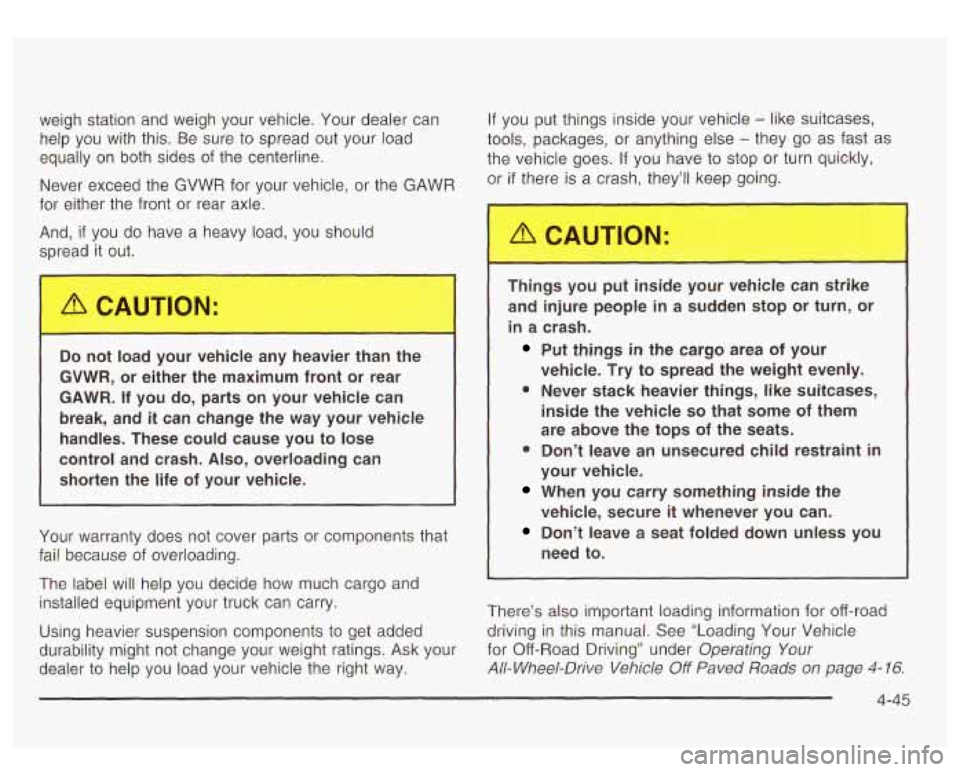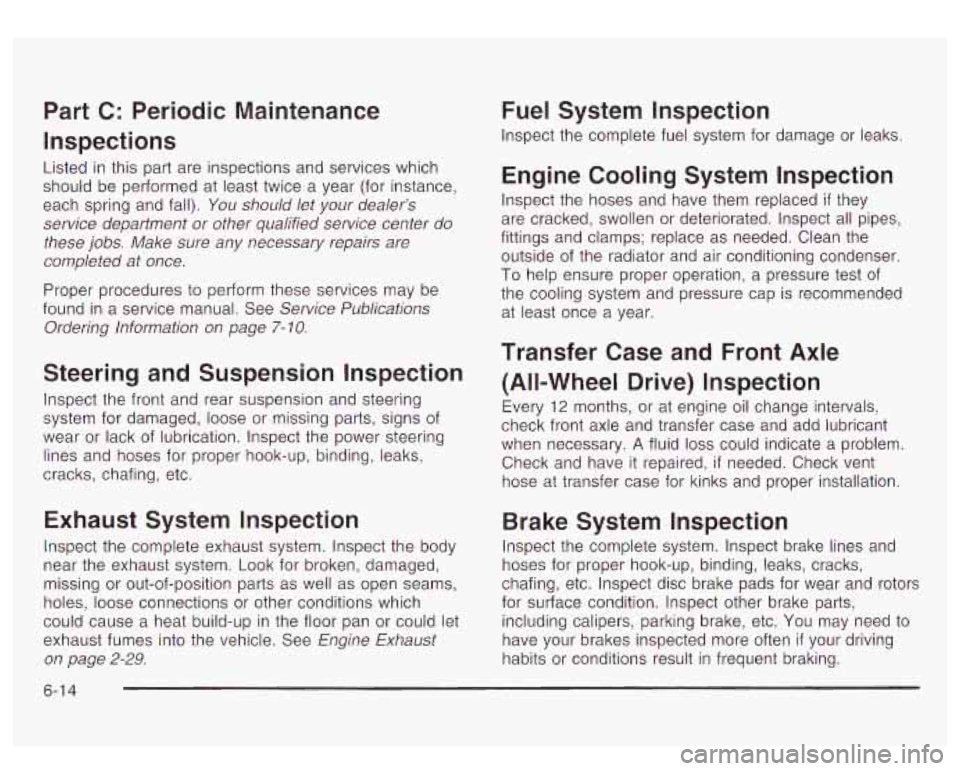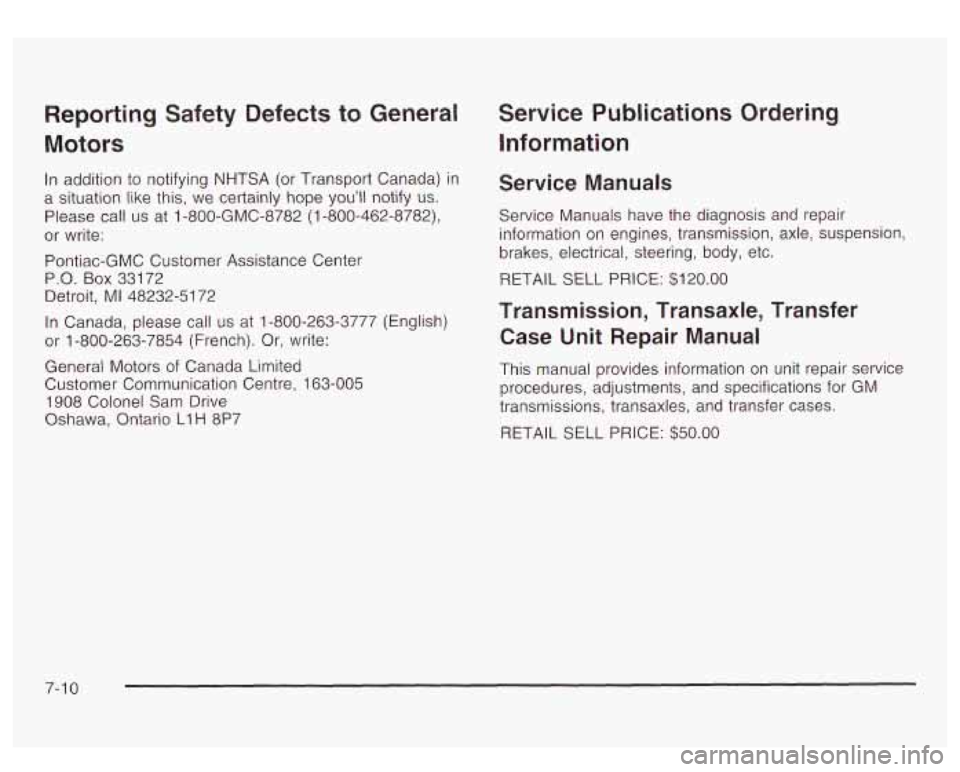suspension GMC YUKON DENALI 2003 Owners Manual
[x] Cancel search | Manufacturer: GMC, Model Year: 2003, Model line: YUKON DENALI, Model: GMC YUKON DENALI 2003Pages: 447, PDF Size: 21.97 MB
Page 197 of 447

BATTERY
If the battery is not charging during operation, this
message will appear
on the DIG. Driving with this
problem could drain your battery. Have the electrical
system checked as soon as possible. Pressing the
select button will acknowledge this message and clear
it
from the DIC display.
SERVlCE AIR
If there is a problem with the air bag system, this
message will be displayed on the DIC. Have a qualified
technician inspect the system for problems. Pressing
the select button will acknowledge this message
and clear
it from the DIC display.
SERVICE BRAKE SYSTE
If a problem occurs with the brake system, this message
will appear on the DIC. If this message appears, stop
as soon as possible and turn
off the vehicle. Restart the
vehicle and check for the message
on the DIC display.
If the message is still displayed, or appears again when
you begin driving, the brake system needs service.
SERVICE 4W
If a problem occurs with the all-wheel drive system? this
message will appear on the DIG.
If this message
appears, stop as
soon as possible and turn off the
vehicle. Restart the vehicle and check for the message
3-54
on the DIC display. If the message is still displayed, or
appears again when you begin driving, the four
wheel drive system needs service.
ONTROL
If a problem occurs with the suspension system, this
message will appear on the DIC.
If this message
appears, stop and turn
off the vehicle. Restart the
vehicle and check for the message on the
DIC display.
If the message is still displayed, or appears again
when you begin driving, the suspension system needs
service.
TURN SIGNAL ON
If a turn signal is left on for 3/4 of a mile (1.2 km), this
message will appear on the display and you will hear a
chime. Move the turn signal/multifunction lever
to the
off position. Pressing the select button will acknowledge
this message and clear
it from the DIC display.
If the liftgate is open while the ignition is in
RUN, this
message will appear on the DIC and you will hear
a chime. Turn
off the vehicle and check the liftgate.
Restart the vehicle and check for the message on the
DlC display. Pressing the select button will acknowledge
this message and clear it from the
DIC display.
Page 260 of 447

Driving in Water
Heavy rain can mean flash flooding, and flood waters
demand extreme caution.
Find out how deep the water
is before you drive through
it. If it’s deep enough to cover your wheel hubs, axles
or exhaust pipe, don’t try
it - you probably won’t
get through. Also, water that deep can damage your
axle and other vehicle parts.
If the water isn’t too deep, drive slowly through it. At
faster speeds, water splashes on your ignition system
and your vehicle can stall. Stalling can also occur
if you
get your tailpipe under water. And, as long as your
tailpipe is under water, you’ll never be able to start your
engine. When you go through water, remember that
when your brakes get wet, it may take you longer
to stop.
I
- - - - -ng through rushing water can be
dangerous. Deep water can sweep your vehicle
downstream and you and your passengers
i could drown. If it’s only shallow water, it can
still wash away the ground from under your
tires, and you could lose traction and roll the
vehicle over. Don’t drive through rushing water.
I I
See Driving in Rain and on Wet Roads on page 4-29 for
more information on driving through water.
After Off-Road Driving
Remove any brush or debris that has collected on the
underbody, chassis or under the hood. These
accumulations can be a fire hazard.
After operation in mud or sand, have the brake linings
cleaned and checked. These substances can cause
glazing and uneven braking. Check the body structure,
steering, suspension, wheels, tires and exhaust
system for damage.
Also, check the fuel lines and
cooling system for any leakage.
Your vehicle will require more frequent service due to
off-road use. Refer
to the Maintenance Schedule
for additional information.
4-27
Page 278 of 447

weigh station and weigh your vehicle. Your dealer can If
you put things inside your vehicle - like suitcases,
help you with this. Be sure to spread out your load
tools, packages, or anything else
- they go as fast as
equally on both sides of the centerline.
the vehicle goes.
If you have to stop or turn quickly,
Never exceed the GVWR for your vehicle, or the GAWR
for either the front or rear axle. or
if there
is a crash, they’ll keep going.
And,
if you do have a heavy load, you should
spread it out.
Do no. .Jad ,3ur vehic., any heavier than the
GVWR, or either the maximum front or rear
GAWR. If you do, parts on your vehicle can
break, and
it can change the way your vehicle
handles. These could cause you to lose
control and crash.
Also, overloading can
shorten the life
of your vehicle.
Your warranty does not cover parts or components that
fail because
of overloading.
The label will help you decide how much cargo and
installed equipment your truck can carry.
Using heavier suspension components to get added
durability might not change your weight ratings. Ask your
dealer to help you load your vehicle the right way. Things you put inside your vehicle can strike
and injure people
in a sudden stop or turn, or
in a crash.
Put things in the cargo area of your
vehicle. Try to spread the weight evenly.
0 Never stack heavier things, like suitcases,
inside the vehicle
so that some of them
are above the tops of the seats.
* Don’t leave an unsecured child restraint in
your vehicle.
When you carry something inside the
vehicle, secure
it whenever you can.
Don’t leave a seat folded down unless you
need to.
There’s also important loading information for off-road
driving
in this manual. See “Loading Your Vehicle
for Off-Road Driving” under Operating Your
All-Wheel-Drive Vehicle
Off Paved Roads on page 4-16.
4-45
Page 279 of 447

Automatic Level Control
The automatic level control rear suspension comes as a
part of the AutorideTMsuspension. See AutorideTM on
page
4-46.
This type of level control is fully automatic and will
provide a better leveled riding position as well as better
handling under a variety of passenger and loading
conditions. An air compressor connected
to the rear
shocks will raise or lower the rear of the vehicle
to maintain proper vehicle height. The system is
activated when the ignition key
is turned to RUN and
will automatically adjust vehicle height thereafter.
The system may exhaust (lower vehicle height) for up
to
10 minutes after the ignition key has been turned to
OFF. You may hear the air compressor operating when
the height is being adjusted.
If a weight-distributing hitch is being used, it is
recommended
to allow the shocks to inflate, thereby
leveling the vehicle prior to adjusting the height.
AutorideTM
The AutorideTM feature provides superior vehicle ride
and handling under a variety
of passenger and loading
conditions.
The system is fully automatic and
uses a computer
controller
to continuously monitor vehicle speed, wheel
to body position, IifVdive and steering position of the
vehicle. The controller then sends signals to each shock
absorber
to independently adjust the damping level to
provide the optimum vehicle ride.
AutorideTM also interacts with the towlhaul mode that,
when activated, will provide additional control of
the shock absorbers. This additional control results in
better ride and handling characteristics when the vehicle
is loaded or towing a trailer. See "Tow/Haul Mode"
under Towing a Trailer on page
4-47 for more
information.
4-46
Page 351 of 447

Used Replacement Wheels Tire Chains
-
Putting a used wheel on your vehicle is
dangerous. You can’t know how
it’s been used
or how far
it’s been driven. It could fail
suddenly and cause a crash. If you have to replace
a wheel, use a new GM original
equipment wheel. Don’t use
ti., ch; ... s. There’s
not ,..ough
clearance. Tire chains used
on a vehicle without
the proper amount of clearance can cause
damage to the brakes, suspension or other
vehicle parts. The area damaged by the tire
chains could cause you to lose control of your
vehicle and you or others may be injured
in a
crash. Use another type of traction device only
if its manufacturer recommends
it for use on
your vehicle and tire size combination and road conditions. Follow that manufacturer’s instructions. To help avoid damage to your
vehicle, drive slowly, readjust or remove
the
device if it’s contacting your vehicle, and don’t
spin your wheels.
If you do find traction devices
that will
fit, install them on the rear tires.
5-62
Page 388 of 447

Section 6 Maintenance Schedule
Maintenance Schedule ...................................... 6.2
Introduction
................................................... 6.2
Your Vehicle and the Environment
.................... 6-2
Maintenance Requirements
.............................. 6.2
How This Section is Organized
......................... 6-3
Part A: Scheduled Maintenance Services
........... 6-4
Using Your Maintenance Schedule
.................... 6-4
Scheduled Maintenance
................................... 6-5
Part
B: Owner Checks and Sewices ................ 6-10
At Each Fuel Fill
.......................................... 6-10
At Least Once a Month
................................. 6-10
At Least Twice a Year
................................... 6-10
~~
At Least Once a Year ................................... 6.11
Part C: Periodic Maintenance Inspections
......... 6.14
Steering and Suspension Inspection
................ 6.14
Exhaust System Inspection
............................ 6.14
Fuel System Inspection
.................................. 6.14
Engine Cooling System Inspection
................... 6.14
Drive) Inspection
....................................... 6.14
Brake System Inspection
................................ 6.14
Part D: Recommended Fluids and Lubricants
.... 6.15
Part E: Maintenance Record
........................... 6.17
Transfer Case and Front
Axle (All-Wheel
6- 1
Page 393 of 447

If the system is ever reset accidentally, you must
change your oil at
3,000 miles (5 000 km) since your
last oil change. Remember
to reset the oil life system
whenever the oil is changed. See Engine Oil on
page
5-13 for information on resetting the system.
An Emission Control Service.
Lubricate chassis components with each engine oil
and filter change.
Lubricate the front suspension, ball joints, steering
linkage, transmission shift linkage and parking brake
cable guides. Ball joints should not be lubricated unless
their temperature is 10°F (-12°C) or higher, or they
could be damaged.
After the services are performed, record the date,
odometer reading and who performed the service on the
maintenance record pages in Part
E of this schedule.
7,500 Miles (12 500 km)
U Check rear/front axle fluid level and add fluid as
needed. Check constant velocity joints and axle seals
for leaking.
page
5-56 for proper rotation pattern and additional
information. (See footnote
+.)
0 Rotate tires. See Tire Inspection and Rotation on
15,000 Miles (25 000 km)
17 Check readfront axle fluid level and add fluid as
needed. Check constant velocity joints and axle seals
for leaking.
page
5-56 for proper rotation pattern and additional
information. (See footnote
+.)
0 Rotate tires. See Tire lnspection and Rotation on
22,500 Miles (37 500 km)
0 Check readfront axle fluid level and add fluid as
needed. Check constant velocity joints and axle seals
for leaking.
page
5-56 for proper rotation pattern and additional
information. (See footnote
+.)
CI Rotate tires. See Tire Inspection and Rotation on
30,000 Miles (50 000 km)
3 Check readfront axle fluid level and add fluid as
needed. Check constant velocity joints and axle seals
for leaking.
page
5-56 for proper rotation pattern and additional
information. (See footnote
+.)
(See footnote t.)
U Rotate tires. See Tire Inspection and Rotation on
U Replace fuel filter. An Emission Control Service.
6-6
Page 401 of 447

Part C: Periodic Maintenance
Inspections
Listed in this part are inspections and services which
should be performed at least twice a year (for instance,
each spring and fall).
You should let your dealer’s
service department or other qualified service center do
these jobs. Make sure any necessary repairs are
completed at once.
Proper procedures
to perform these services may be
found in a service manual. See Service Publications
Ordering Information on page
7- IO.
Steering and Suspension Inspection
Inspect the front and rear suspension and steering
system for damaged, loose or missing parts, signs of
wear or lack of lubrication. Inspect the power steering
lines and hoses for proper hook-up, binding, leaks,
cracks, chafing, etc.
Exhaust System Inspection
Inspect the complete exhaust system. Inspect the body
near the exhaust system. Look for broken, damaged,
missing or out-of-position parts as well as open seams,
holes, loose connections or other conditions which
could cause a heat build-up in the floor pan or could let
exhaust fumes into the vehicle. See Engine Exhaust
on page 2-29.
Fuel System Inspection
Engine Cooling System Inspection
Inspect the complete fuel system for damage or leaks.
Inspect the hoses and have them replaced
if they
are cracked, swollen or deteriorated. Inspect all pipes,
fittings and clamps; replace as needed. Clean the
outside of the radiator and air conditioning condenser.
To help ensure proper operation, a pressure test of
the cooling system and pressure cap is recommended
at least once a year.
Transfer Case and Front Axle
(All-Wheel Drive) Inspection
Every 12 months, or at engine oil change intervals,
check front axle and transfer case and add lubricant
when necessary.
A fluid loss could indicate a problem.
Check and have it repaired,
if needed. Check vent
hose at transfer case for kinks and proper installation.
Brake System Inspection
Inspect the complete system. Inspect brake lines and
hoses for proper hook-up, binding, leaks, cracks,
chafing, etc. Inspect disc brake pads for wear and rotors
for surface condition. Inspect other brake parts,
including calipers, parking brake, etc. You may need
to
have your brakes inspected more often if your driving
habits or conditions result in frequent braking.
6-1 4
Page 417 of 447

Reporting Safety Defects to General
Motors
In addition to notifying NHTSA (or Transport Canada) in
a situation like this, we certainly hope you’ll notify us.
Please call us at
1 -800-GMC-8782 (1 -800-462-8782),
or write:
Pontiac-GMC Customer Assistance Center
P.O. Box 33172
Detroit,
MI 48232-51 72
In Canada, please call us at 1-800-263-3777 (Englishj
or 1-800-263-7854 (French). Or, write:
General Motors of Canada Limited
Customer Communication Centre, 163-005
1908 Colonel Sam Drive
Oshawa, Ontario L1
H 8P7
Service Publications Ordering
Information
Service Manuals
Service Manuals have the diagnosis and repair
information on engines, transmission, axle, suspension,
brakes, electrical, steering, body, etc.
RETAIL
SELL PRICE: $120.00
Transmission, Transaxle, Transfer
Case
Unit Repair Manual
This manual provides information on unit repair service
procedures, adjustments, and specifications for GM
transmissions, transaxles, and transfer cases.
RETAIL
SELL PRICE: $50.00
7-1 0
Page 432 of 447

Inspection (cont.)
Instrument Panel
Steering
and Suspension
...............
Cluster ......................... .....................
Overview ..............................................
Instrument Panel Brightness ............................
Instrument Panel Fuse Block ...........................
Interior Lamps ...............................................
Interior Plastic Components .............................
Introduction
Transfer Case (All-Wheel Drive) Inspection
.....
. 6-14
. 3-29
... 3-4
. 3-16
. 5-88
. 3-16
. 5-79
. 6-14
Jump Starting
........................ 5-40
Key Lock Cylinders Service
........ ........... 6-1 1
Keys
........................................................... 2-3
Keyless
Entry System
....................................... 2-4
L
Lamps
Exterior
...................................................... 3-1 3
Interior
....................................................... 3-1 6
Lamps On Reminder
....................................... 3-14
Lap-Shoulder Belt
........................................... 1-31 LATCH
System
Child Restraints
........................................... 1-61
Securing a Child Restraint Designed for the
LATCH System
........................................ 1-63
Leather
......................................................... 5-79
LEFT REAR DOOR AJAR
................................ 3-56
Liftgate/LiftgIass
.............................. ........ 2-13
Liftglasdliftgate
.............................. .... 2-13
Light Leaving Your Vehicle With the Engine Running
...... 2-27
Air Bag Readiness
....................................... 3-31
Anti-Lock Brake System Warning
................... 3-35
Brake System Warning
................................. 3-34
Charging System
..................................... 3-33
Cruise Control
................. ................ 3-41
Low Fuel Warning
................................... 3-42
Malfunction Indicator
................................ 3-38
Passenger Air Bag Status Indicator
............ 3-32
Safety Belt Reminder
................................... 3-30
Security
..................................................... 3-41
Tow/Haul Mode
........................................... 3-42
Traction
Off ................................................ 3-36
Listening
to a DVD ..................................... 3-72
Loading Your Vehicle
................................... 4-44
Lockout Protection
.......................................... 2-13
Locks Delayed Locking
........................................... 2-9
Door
........................................................... 2-8
Lockout Protection
....................................... 2-13
Power Door
.................................................. 2-9
8